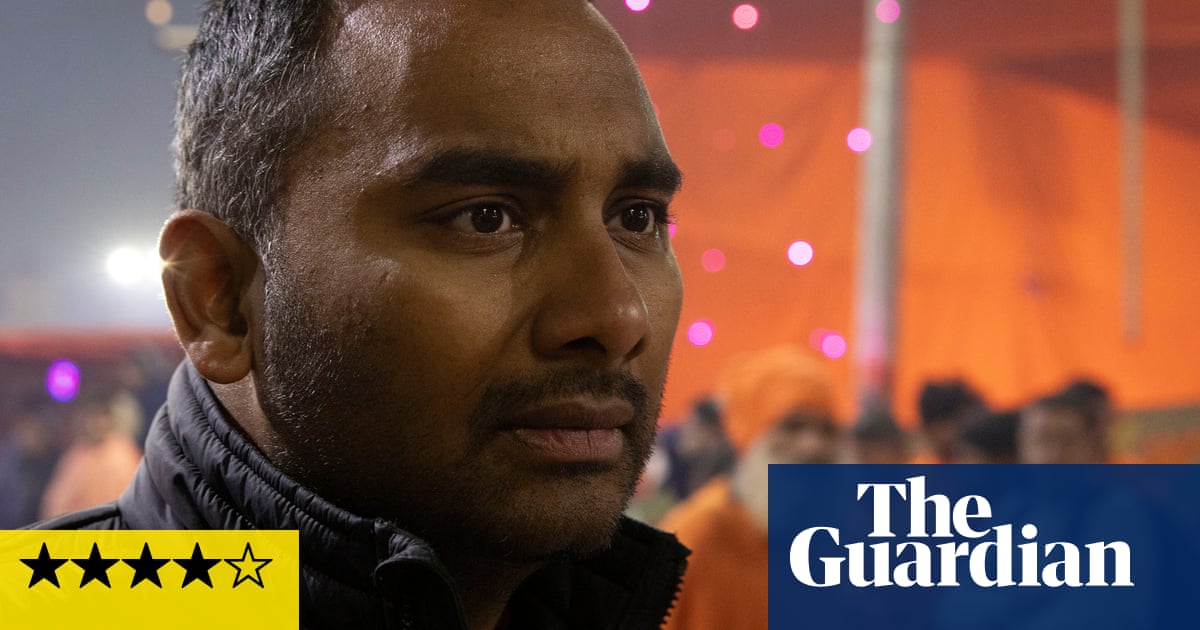Three years ago Amol Rajan’s father died unexpectedly of pneumonia. Ever since, as the BBC journalist and broadcaster puts it at the start of Amol Rajan Goes to the Ganges, “I’ve been in a bit of a funk.” I get it. As a fellow second-generation kid of Indian immigrants (and journalist from southwest London to boot) I, too, have been in a funk since my mother died (two years before Rajan’s father, at the same age, 76, as him). In Rajan’s case, his grief plunges him into a search for belonging and an attempt to reconnect with his Hindu roots. Where might such a quest take him? To the largest gathering of humanity on earth. TheKumbh Mela, where over 45 days at the start of this year half a billion Hindus gathered on the sacred banks of the Ganges. The question Rajan poses, and it’s a pertinent one for many, is whether “an atheist like me can benefit from a holy pilgrimage”.
This is the deeply personal premise of what turns into an intimate, moving, entertaining yet oddly depoliticised documentary considering both the day job(s) of its presenter and the fact that the Kumbh Mela is the world’s biggest Hindu festival, funded by a prime minister whose success is built on his identity as a Hindu nationalist strongman. Only once is Narendra Modi mentioned, halfway through, and it’s in the context of his government investing £600m in the biggest Kumbh Mela to date: a mega-event owing to a specific celestial alignment that occurs once in 144 years. We know, watching Rajan’s film in the aftermath, thatat least 30 people were killedand many more injured in terrifying crowd crushes. As much as he is spiritually shaken, even altered, by the experience, he’s also traumatised by what he sees. “The people in front of me were just stepping on women,” Rajan says after he and his fixer are forced to turn back due to reports of a stampede 800 metres ahead. “Lots of very poor, very old, very fragile, possibly quite sick women … they were like human debris on the floor. Kids as well.”
Before he flies to Delhi, Rajan returns to his childhood. Born in Kolkata, he was three years old when his family moved to southwest London in 1986. On the three-year anniversary of his dad’s death, he goes home to Tooting with his mum. “This was my field of dreams,” he says wistfully as they drive past the pitch where he played cricket as a boy. “You were very chubby … pleasantly plump,” his mum recalls with a giggle. The loving, mischief-laden sparring between mother and son make for the most touching moments. Like when Rajan’s mother watches him flip a dosa and quips: “You are already getting spiritually enhanced!” Or when he jokily asks, “Do you want me to come back a mystical yogi?” and his mum gets serious and says, “No. I want you to be calmer, to take life in your stride.”
What emerges, above all, is how grief-stricken Rajan is by his father’s death. “I’ve avoided thinking about him because I found it too painful,” he admits, sitting on a bench with his mum overlooking the Thames where they scattered his ashes (the exact same stretch where we scattered my mother’s ashes). Weeping over a framed portrait of his father, the rawness of the loss overwhelms him. “I really miss that smile,” Rajan says. “I miss his love. Oh god, I loved him so much.”
In India, the documentary ups its pace as Rajan heads for the city of Prayagraj, joining the millions of Hindu pilgrims seeking moksha (liberation from the cycle of birth and death and the end of suffering). He spends the night in an ashram withsadhuswho, hilariously, stay up on their phones watching YouTube and WhatsApping videos to one another. He’s astonished by the magnitude of the megacity temporarily built on 15 square miles of flood plain to house the Kumbh Mela – the 30 pontoon bridges, 250 miles of road and 150,000 toilets. He’s just as blown away by all the men who look like his father.
The pilgrimage to the Sangam – the sacred confluence of the Ganges, Yamuna and mythical Saraswati river – takes three days. Along the way Rajan, a congenial, very English guide, becomes more and more introspective. He puts on orange robes, talks to pilgrims in the smattering of Hindi he’s barely spoken since childhood, and begins to feel a “tremendous affinity and fellow feeling with others”. It’s moving and subtly handled. By the end Rajan has failed to make it to the Sangam because of the dangerous crowd surges. Instead he performs an ancient funeral rite for his father, finds a safe spot to enter the Ganges, releases his dad’s soul and plunges underwater. Has the atheist been healed by the largest gathering of people ever recorded in history? Kind of. “There’s a power in doing something that a lot of people have done for a very long time,” is how he carefully puts it, high as a kite. What Amol Rajan Goes to the Ganges expresses most powerfully of all, certainly to this fellow bereaved Hindu, are the irresolvable particularities, and commonalities, of second-generation grief.
Amol Rajan Goes to the Ganges aired on BBC One and is on iPlayer now.
